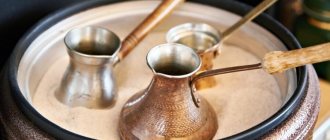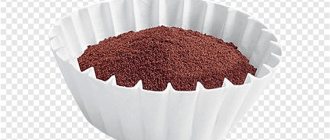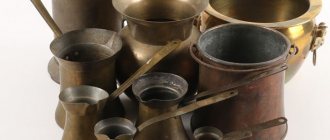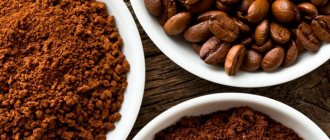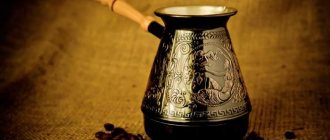A Turkish coffee pot called ibrik or cezve is an ideal device for preparing specialty coffee. Traditionally they are made of copper, but today Turks made of stainless steel, glass, and ceramics are also common.
Among the many devices designed for brewing coffee, a ceramic pot is the most popular after copper ones.
The history of the emergence of ceramic Turks
Since ancient times, humanity has made kitchen utensils from ceramics. The oldest pottery created by man dates back to at least 24,000 BC and was found in Czechoslovakia.
The term "ceramics", with Greek roots, refers to products made from clay and other inorganic materials that are subjected to firing processes and subsequent cooling.
Ceramic Turkish coffee pots appeared much later than their copper counterparts. However, its popularity instantly boosted its ability to heat up evenly and evenly and retain heat for a long time.
Which Turk for an induction cooker is best to buy, depending on the manufacturer
When choosing a specific model, you need to take into account the manufacturer, since there are models from several companies on the market. They all have their positive and negative sides.
Gipfel company presents the widest range of products
Turks for induction cooker Gipfel, Korkmaz, Erringen
In fact, among the main brands producing special Turks for induction devices, 4 manufacturers predominate. It is their products that are considered the best and are popular among gourmets:
- Gipfel. A brand that produces a wide range of Turks for brewing coffee on induction panels. The model range is represented by the largest variety of volumes - 390, 500 and 700 ml. All cezves of this brand are made of polished steel, have a wide neck and a fairly thick bottom (from 6 to 8 mm).
- Korkmaz. This manufacturer specializes in producing Turkish sets of different volumes. Just one set includes three pieces, the smallest of which has a capacity of only 20 ml, and the largest - 400 ml. One of the features is the presence of a comfortable handle with silicone inserts.
- Erringen. A company that also produces stainless steel cezves. The company does not offer the widest range of models. It includes 360 and 720 ml models. Among the distinctive features, comfortable handles should be noted.
Under the Tima brand, copper cezves with a narrow neck are produced to obtain a rich taste
Advantages of ceramic Turks
This cezve is multifunctional. In the device you can safely brew all sorts of varieties with different smells and tastes, without fear of mixing them. Having a highly porous structure, ceramics and clay allow oxygen to pass through, enriching coffee with taste and aroma. A thick-walled coffee pot heats the contents slowly and the result is real Turkish coffee, similar in properties to a drink brewed in the classic way by immersing it in sand.
If a copper product cools instantly when removed from the heat, a ceramic product retains heat for a long time. To deeply develop the aroma and further saturate the coffee, it is left to stand for additional time after brewing.
Cezves are environmentally friendly and safe for human health.
When brewing coffee, remove the cezve from the heat source immediately after foam begins to form. This takes into account the property of ceramics, such as low thermal conductivity.
A ceramic pot is extremely easy to care for. While copper and cupronickel pots are difficult to clean from residues of grounds, a ceramic coffee pot is very easy to clean and does not require any special care.
The ceramic cezve has the effect of a thermos. It has high heat capacity and low thermal conductivity. Even after removal from the flame, the effect of heat remains and the coffee simmers for some time. Turka is not subject to the oxidation process.
The exclusive disadvantage of such a device is its fragility. The quality of the cezve depends on the manufacturing method. This factor is worth considering when choosing a Turk.
Gorenje TCM 330W
The most popular electric Turk in the Russian Federation in an updated form.
Previously, this manufacturer produced an electric Turk without auto-shutdown, the Gorenje TCM 300W, which was discontinued in 2022.
The device is of the correct shape, the inner part is made of stainless steel, the outer part is made of plastic. This improved the thermal insulation of the case compared to the steel version. The reliability of the electric Turk is not inferior to its progenitor.
Improvements: more ergonomic handle, two spouts, power reduced to 550 W. Previously, it was all 800. This helped to lengthen the brewing time, which means Turkish coffee turns out better.
- Volume: 330 ml
- Handle: removable plastic
- Colors: white and black
- Base included
For better extraction, I would like even slower heating, although it is not as fast as the others. Bringing time to a boil is about two minutes.
How to choose a ceramic cezve
The main thing is that the material affects the properties of the products.
Ceramic Turks do not retain the smell of brewed coffee. Therefore, they are excellent for drinks with specific flavors.
Those for whom the quality of absorption of aromas is important should buy a copper or clay cezve without firing. Such devices produce a richer drink with each brew. Connoisseurs of this type of coffee do not thoroughly wash the cezve.
Porcelain is another type of ceramic. It is obtained from a combination of clay and various inorganic compounds and fired at high temperatures.
The following types of ceramics exist:
- Porcelain: hard and soft;
- Pariyan (soft porcelain not treated with glaze);
- Biscuit (hard porcelain not treated with glaze).
Porous types of ceramics:
- Delicate earthenware treated with glaze;
- Ordinary earthenware, treated with glaze;
- Terracotta (ceramics not treated with glaze).
Ceramics are divided into two types: coarse and fine.
Coarse ceramics include pottery, and fine ceramics include porcelain, majolica, faience and stone ceramics.
Another classification is also used, which includes the main chemical compound in the composition: carbide, aluminum oxide, zirconium, nitride ceramics, etc.
Ceramic cezve is divided into glazed and unglazed.
The porous structure of the unglazed cezve absorbs all the aromas of coffee. This model is only suitable for preparing one type of coffee.
The advantages of glazed models are additional coating.
By filling the cavities of the clay, the glaze prevents the absorption of aroma.
The taste of coffee also depends on the shape of the ceramic cezve. The shape of such products comes in two types: Turkish and Armenian.
Turkish-shaped cezves are characterized by a sharp transition from the width of the bottom to an overly narrow neck. The Armenian shape is more like a cone.
Turks made of clay
When heat treated, clay Turks acquire fire resistance and chemical resistance. Such products are not glazed. The porous structure of the material is completely preserved. Absorbs odors and oils.
If you want to fully experience the properties of individual varieties, you need to rinse the coffee pot thoroughly and warm it up a couple of times with water.
Ceramics with glaze
To protect the ceramics from mechanical damage and smooth the structure, the cezve is treated with glaze before firing. The coating protects against external contacts. Clay walls do not absorb foreign odors.
Advantages of ceramics with glaze:
- You can make any type of coffee;
- Resistant to staining;
- not susceptible to oxidation and resistant to chemical reactions.
- The smooth surface is not difficult to clean and traces of the finished drink do not remain after simple warm water and ordinary cleaning products.
- A ceramic cezve with glaze is a good opportunity to experiment with mixtures and taste flavored drinks with specific tastes.
To fry or not to fry?
With all this, the most important taste criterion for coffee is its degree of roasting:
- Light roasting – the mildest taste of the drink, retains the most original taste of the beans, since the fruits are least amenable to heat treatment, this type is often more expensive than others;
- Medium roast – the taste of the drink is stronger than with light roasting, the acidity of the taste decreases;
- Strong degree of roasting - coffee has the strongest taste and bright aroma, reminiscent of a sweetish-smoky aroma, mainly used for extra-strong espresso, and is extremely rarely expensive.
How to use a ceramic Turk
Ceramic material is not resistant to sudden temperature changes. To prevent the Turk from suddenly breaking, you must adhere to certain rules.
Ceramic Turk on a gas stove
If the gas stove burner is larger than the bottom of the ceramic Turk, then you need to use a flame divider. On an electric stove with a spiral heater, a disc adapter is useful. An induction surface requires an adapter with special ferromagnetic properties. Glass-ceramic surfaces are ideal for brewing coffee in a Turk because such stoves heat evenly and there is no need to use additional protective devices.
The casing should stand firmly on the surface.
The safety of the Turk can be ensured by first placing the cezve on the surface before turning it on.
A durable, heat-treated ceramic Turk can be placed directly on a gas stove over the fire.
A handmade ceramic Turk with convex elements can be protected from fire flames using a metal divider.
An electric stove with a spiral-shaped heating element does not distribute heat evenly. Therefore, a metal adapter is also used on this type of stove.
The ceramic coffee pot, removed from the flame, must be placed on a dry stand.
When cleaning, do not use abrasive materials, aggressive acids or harsh cleaners.
How to clear a cezve from burnt remains of a drink
- Pour warm water into the vessel.
- Stir and dissolve pre-ground laundry soap and soda ash in it.
- Boil the solution over low heat until all residues are removed.
- Pour out the water and rinse the cezve with boiling water, cleaning it with a gentle washcloth. Wipe the dishes dry with a soft cloth.
To wash a ceramic cezve in the dishwasher, you need to carefully read the manufacturer’s recommendation about whether special technologies were used in production. There is no clear prohibition against washing ceramics in the dishwasher.
Popular manufacturers
Many gourmets know that the perfection of coffee is influenced by many factors, including the quality of beans, water, and utensils. Manufacturers are responsible for the quality of cookware. A certain percentage of coffee lovers are sure that the best Turks are produced to order in eastern countries. However, the price for such an exclusive item sometimes exceeds all reasonable limits.
Cezves made by other craftsmen, for example from Brazil, are no less in demand. Among the many brands, Ceraflame occupies a special place, specializing in the manufacture of ceramic tableware of various categories.
Ceraflame Turks can withstand a temperature range from -30 to 900 degrees.
The company provides a 10-year guarantee for each type of product. Ceraflame Turks can withstand a temperature range from -30 to 900 degrees. Dishes from this brand can be washed in dishwashers and used on open fires and ovens.
Among the large selection of models, several stand out:
- Ibriks is a Turkish woman distinguished by grace and elegance. The product is covered with smooth enamel, which eliminates unnecessary roughness and discomfort. Suitable for all types of ovens, including microwave;
The product is covered with smooth enamel, which eliminates unnecessary roughness and discomfort.
- From the same series, but from another Ibriks Hammered collection, a Turkish model made of heat-resistant ceramics stood out. It has a great design in a classic shape. It is not afraid of high temperatures, creating the effect of simmering rather than cooking in the process.
It has a great design in a classic shape.
- Gutenberg. Their ceramic cezves have a magnificent design, a narrow neck with a small spout, a wide bottom, and a heat-resistant handle. They are suitable for all types of slabs and do not require special care.
A lot of recommendations and advice from experts will not make you fall in love with this or that type of Turks. Love and respect for a particular Turk accumulates over the years, based on trial and error.
Brewing coffee
The ceramic Turk needs to be wiped thoroughly and dry before brewing an invigorating drink. Only fresh coffee beans give the best quality to the drink. Grinding – medium and fine fineness.
The amount of powder added depends on the type of coffee. For one cup, the proportion of coffee and water is: approximately 10 grams (1 heaped tsp) per 40 milliliters of water.
Brewing method
- Place ground powder in the cezve.
- Add sugar to taste.
- Pour in half the calculated volume of water and wait until the first bubbles appear.
- Pour in the remaining amount of water, leaving almost one third of the Turk empty so that the coffee does not run away.
- Place the Turk on a low flame. If necessary, use either a disc or a fire spreader designed for different types of stoves.
- Stir the drink.
- Remove the Turk from the stove quickly and immediately, as soon as the foam starts to rise. Let the brew stand for a couple of minutes.
- Pour the coffee and start serving.
You need to heat the coffee twice or thrice to get a thick foam. The drink is brewed in the classic way. They stand for a couple of minutes. Then the heating process begins again. The resulting foam, without disturbing the structure, must be transferred to a serving container and then poured with coffee.
After making coffee, the ceramic pot should be cooled naturally. Only after this do you start washing. Otherwise, the temperature difference will lead to a crack or complete failure.
Ceramic products are produced both manually and in production. The uniqueness of the handicraft is distinguished in the first case. Meanwhile, appliances that lack the personality of the industry also have their own charm. The price also differs significantly. Handmade products are valued much more than industrial ones.
Cezves of two parts are connected by soldering; such a seam may come apart over time. In addition, the narrow neck makes cleaning difficult.
Turks produce ceramics in a wide range. The price for them depends on the design and volume of the cookware. Handles are made from the following types of raw materials: wood, ceramics and bakelite.
Ceramic cezves are varied in design: there are products with elegant decor and minimalist decoration.
Cezves from well-known brands are priced more expensive by large companies.
A small-capacity ceramic pot (from 150 ml) will cost 5,000 tenge, with a volume of 300 – 400 ml it costs from 6,000 – 9,000 tenge, 500-700 ml – from 9,000 to 18,000 tenge.
Helpful coffee brewing tips
To make the drink a success, use 4 tips.
- When cooking, add a pinch of salt to the liquid. A flavor enhancer will reveal additional shades and help you experience the characteristics of the variety.
- Dry ingredients are mixed with dry ingredients, liquid, viscous ingredients are mixed with water or milk. Only after this are they connected to each other. You can deviate from the rule only when the recipe technology involves other steps.
- It is better to calcinate the medium, coarse powder before cooking. Not for long, up to a minute, so that the raw material does not have time to char. The action will help release the aroma.
- When boiling, the aromatic oils leave the drink. If you miss a moment, let the liquid boil, it will turn out less rich.
Try not to neglect nuances and technologies. Every little detail is important for the taste of the drink, such as the heating speed and the thickness of the bottom of the cezve.
If you don’t have a coffee grinder at home, ask the store to grind the raw materials. But then do not take more than 50 g - the reserves will quickly be used up and will not have time to lose their taste.
